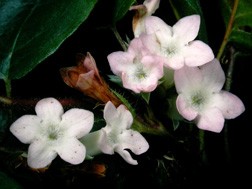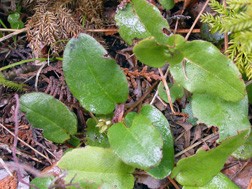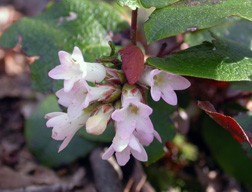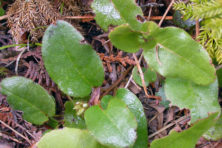Trailing Arbutus
- Share
- Tweet
- Pin
- Share
History tells us that the Pilgrims, having crossed the Atlantic Ocean in their seaworthy craft the Mayflower, landed at Plymouth in 1620 (in what today is Massachusetts). After barely surviving their first brutal winter, come spring, a very sweetly scented wildflower is said to have provided those stalwart people with hope for the coming year. Surely it was not only due to the time of year that those wildflowers were in bloom but also to the name of their highly revered ship that led them to call the welcome little plant the Plymouth Mayflower.

The nectar and fragrance of the Arbutus lures insects, which may account for the tiny dark specks on the petals.
The colloquial index in a plant reference I frequently use, Gray’s Manual of Botany, Eighth Edition, refers to only one plant as the Mayflower, the Trailing Arbutus. Today, relatively few people have ever seen or even heard of the Trailing Arbutus, but a good many do commonly refer to several different native wildflowers, especially the Hepatica, as the Mayflower.
I consider the Trailing Arbutus to be my very first official wildflower introduction to the Ridges Sanctuary. Having been hired by the board of directors to serve, on a trial basis for one summer, as their summer tour guide at the Ridges, it was Miss Emma Toft, board member, who invited me to hike with her in late April of 1964 onto some of the Ridges’ trails. How clearly I recall her arriving at a somewhat shaded area along Wintergreen Ridge and carefully kneeling down along the south side of the narrow path to inhale the fragrance of a wildflower.
Soon I was following her example, gently kneeling down within the confines of the trail, making sure my feet didn’t accidently disturb any plants on the opposite side of the trail, lowering my head to the ground and then inhaling as deeply as I could perhaps the most wonderfully spicy and fragrant flower perfume I had ever sampled. The only other wildflower that can compare in fragrance to the Trailing Arbutus is the Twinflower of late June.
Not only did Emma impress upon me the special nature of that wildflower, but also its rarity and the all-important need of protecting all plants in the Ridges while encouraging visitors to remain strictly on the trails at all times no ifs, ands or buts!

The hardy Trailing Arbutus may be in flower with snow still lingering. The leaves are from last year.
My fourth book, Toft Point, A Legacy of People and Pines, was published in 1998 and in it is a short section describing the two years the oldest Toft boy, William or “Will” as the family called him, worked elsewhere. Will found a job working in the pinery near Rapid River in the Upper Peninsula of Michigan for two years because of hard times and lack of jobs in Door County. Will’s parents, his oldest brother Sam, and his five sisters missed him terribly and wrote to him often.
Fortunately Will saved many of the letters, which I was able to make use of in writing the chapter in the Toft book. Young sister Lucy, age 9, wrote to Will on April 19, 1898: “We went down on the riges [Ridges] Friday and everybody got some beauties in blossom.”
I can only assume that the only wildflower in bloom at that time of the year was the Trailing Arbutus. It was in one of the letters that a beautifully preserved leaf, still very recognizable after 100 years, turned out to be that of the Trailing Arbutus!
Later that year, on July 7, 1898, little Emma Toft, age 7, wrote: “I would send you some flowers but I dastin (sic).” The word Emma used, “dastin,” assumedly was her version of “dasint,” “dast not” or “must not.” One wonders if the girls had been scolded by their mother for picking and sending little sprigs of flowers to Will in some of their previous letters. Unfortunately none of the letters that Will wrote home were ever saved.
Search the world over and you will find only two species of Trailing Arbutus, one in Japan, the other in North America. Botanists, in their search for appropriate scientific names of flowers, chose Epigaea repens (ep-i-JEE-a REE-pens) for this favorite early spring flower. Epigaea is Greek meaning ‘upon the earth,’ while repens means ‘running on the ground.’

These are the tightly closed buds in late fall.
Technically Trailing Arbutus is a shrub, no matter how closely to the ground is grows. It belongs to the heath family, one of my favorites, and is grouped with Bog Rosemary, Leatherleaf, Sweet Gale, Wintergreen, Bearberry and others. All of these are native to Wisconsin and especially to the Ridges Sanctuary.
What’s fascinating about the Trailing Arbutus is that in order to blossom extremely early each spring, occasionally with snow still lingering nearby, the flower buds are already well formed by the previous autumn season. Locate some plants, say in later October, carefully nudge the leathery leaves aside and you should easily be able to see the well-formed flower buds resting close to the ground.
The Trailing Arbutus is a fussy little plant to say the least, as wild and untamed as the wind. Shade, sandy, aerated acid soil and an affinity for being near evergreen trees or shrubs are some of its requirements for good growth. In spite of its demanding needs, it enjoys a wide distribution generally in the eastern half of North America.
People drink in its heady perfume each spring from Newfoundland to Saskatchewan and as far south as Florida. We photographed some in full bloom at our friends’ home in western North Carolina during the last week of this past April. This widespread occurrence might lead one to imagine that these flowers are abundant. Actually they are becoming increasingly rare every year.

Trailing Arbutus in North Carolina.
Their beautiful waxy, white to pink, five-petaled flower, coupled with their ambrosial scent, have sadly led to their almost total disappearance in many sections of their original range. It was a fashionable custom for many years for people to decorate their homes with bowls and trays full of Trailing Arbutus lacing the air with its heavenly aroma.
I like to think that some Native Americans kneeled down years ago each spring in this region, right about now, to fill their lungs over and over with the sweet delicious fragrance of the Trailing Arbutus. And perhaps, as I have, they too developed a spring ritual which took them to their own “private” garden, away from others where they would commune with the most secretly precious of spirits – known and understood only by them.
May “Trailing Arbutus Time” become a special annual event each spring in your life!


